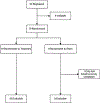Pilot study of fractional CO2 laser therapy for genitourinary syndrome of menopause in gynecologic cancer survivors
- PMID: 33358206
- PMCID: PMC7773136
- DOI: 10.1016/j.maturitas.2020.10.018
Pilot study of fractional CO2 laser therapy for genitourinary syndrome of menopause in gynecologic cancer survivors
Abstract
Purpose: The objectives of this study were to evaluate the feasibility and efficacy of fractional CO2 laser therapy in gynecologic cancer survivors.
Methods: This was a pilot, multi-institutional randomized sham-controlled trial of women with gynecologic cancers with dyspareunia and/or vaginal dryness. Participants were randomized to fractional CO2 laser treatment or sham laser treatment. The primary aim was to estimate the proportion of patients who had improvement in symptoms based on the Vaginal Assessment Scale (VAS). Secondary aims included changes in sexual function assessed using the Female Sexual Functioning Index (FSFI) and urinary symptoms assessed using the the Urinary Distress Inventory (UDI-6).
Results: Eighteen women participated in the study, ten in the treatment arm and eight in the sham arm. The majority of participants had stage I (n = 11, 61.1 %) or II (n = 3, 16.7 %) endometrial cancer with adenocarcinoma histology (n = 9, 50 %). In total, 15 (83.3 %) of the participants completed all treatments and follow-up visit. There was no difference in the change in the median VAS score from baseline to follow-up. However, there was an improvement in change in the median total FSFI score with treatment compared with sham (Δ 6.5 vs -0.3, p = 0.02). The change in the median UDI-6 score was lower in the treatment arm (Δ -14.6 vs -2.1, p = 0.17), but this was not statistically significant. There were no reported serious adverse events.
Conclusions: Fractional CO2 laser therapy is feasible in gynecologic cancer survivors, with preliminary evidence of safety. In addition, there was preliminary evidence of improvement in sexual function compared with sham treatment. Clinicaltrial.gov Identifier: NCT03372720 (OSU-17261; NCI-2017-02051).
Keywords: Atrophic vaginitis; Cancer survivors; Dyspareunia; Genitourinary syndrome of menopause; Laser therapy; Sexual function; Vaginal atrophy; Vaginal dryness.
Copyright © 2020 Elsevier B.V. All rights reserved.
Conflict of interest statement
Conflict of interest
Charles Loprinzi reports personal fees from PledPharma, Disarm Therapeutics, Asahi Kasei, Metys Pharmaceuticals, OnQuality, and Mitsubishi Tanabe, which are all outside the submitted work. The other authors have no relevant conflicts of interest or financial disclosures. No financial support was provided by Hologic inc. The laser device was provided by loan to OSU from Hologic/Cynosure. None of the investigators received financial support from Hologic/Cynosure. The company was not involved in study data analysis or manuscript preparation.
Figures




Similar articles
-
A Double-Blind Randomized Sham-Controlled Trial to Evaluate the Efficacy of Fractional Carbon Dioxide Laser Therapy on Genitourinary Syndrome of Menopause.J Sex Med. 2021 Apr;18(4):761-769. doi: 10.1016/j.jsxm.2021.01.188. Epub 2021 Mar 20. J Sex Med. 2021. PMID: 33757774 Clinical Trial.
-
Patient-reported sexual function of breast cancer survivors with genitourinary syndrome of menopause after fractional CO2 laser therapy.Menopause. 2021 Feb 1;28(6):642-649. doi: 10.1097/GME.0000000000001738. Menopause. 2021. PMID: 33534429
-
Fractional CO2 laser therapy for genitourinary syndrome of menopause for breast cancer survivors.Support Care Cancer. 2020 Aug;28(8):3669-3677. doi: 10.1007/s00520-019-05211-3. Epub 2019 Dec 6. Support Care Cancer. 2020. PMID: 31811486
-
Sexual Function in Women Suffering From Genitourinary Syndrome of Menopause Treated With Fractionated CO2 Laser.Sex Med Rev. 2017 Oct;5(4):486-494. doi: 10.1016/j.sxmr.2017.07.003. Epub 2017 Aug 23. Sex Med Rev. 2017. PMID: 28843942 Review.
-
CO2-Laser therapy and Genitourinary Syndrome of Menopause: A Systematic Review and Meta-Analysis.J Sex Med. 2022 Mar;19(3):452-470. doi: 10.1016/j.jsxm.2021.12.010. Epub 2022 Jan 29. J Sex Med. 2022. PMID: 35101378
Cited by
-
Safety and efficacy of non-ablative CO2 laser treatment of vulvo-vaginal atrophy in women with history of breast cancer.Arch Gynecol Obstet. 2024 Apr;309(4):1575-1583. doi: 10.1007/s00404-023-07323-y. Epub 2024 Jan 23. Arch Gynecol Obstet. 2024. PMID: 38253692
-
The evidence behind the use of LASER for genitourinary syndrome of menopause, vulvovaginal atrophy, urinary incontinence and lichen sclerosus: A state-of-the-art review.Acta Obstet Gynecol Scand. 2022 Jun;101(6):657-692. doi: 10.1111/aogs.14353. Epub 2022 Apr 28. Acta Obstet Gynecol Scand. 2022. PMID: 35484706 Free PMC article. Review.
-
Effects of Non-Ablative Solid-State Vaginal Laser (SSVL) for the Treatment of Vulvovaginal Atrophy in Breast Cancer Survivors after Adjuvant Aromatase Inhibitor Therapy: Preliminary Results.J Clin Med. 2023 Aug 31;12(17):5669. doi: 10.3390/jcm12175669. J Clin Med. 2023. PMID: 37685736 Free PMC article.
-
New Innovations for the Treatment of Vulvovaginal Atrophy: An Up-to-Date Review.Medicina (Kaunas). 2022 Jun 6;58(6):770. doi: 10.3390/medicina58060770. Medicina (Kaunas). 2022. PMID: 35744033 Free PMC article. Review.
-
Epidemiology, etiology and treatment of female vaginal injury.Reprod Health. 2025 May 6;22(1):65. doi: 10.1186/s12978-025-02017-x. Reprod Health. 2025. PMID: 40329296 Free PMC article. Review.
References
Publication types
MeSH terms
Substances
Associated data
Grants and funding
LinkOut - more resources
Full Text Sources
Other Literature Sources
Medical

